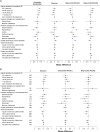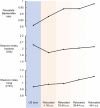Gut microbiome composition in the Hispanic Community Health Study/Study of Latinos is shaped by geographic relocation, environmental factors, and obesity
- PMID: 31672155
- PMCID: PMC6824043
- DOI: 10.1186/s13059-019-1831-z
Gut microbiome composition in the Hispanic Community Health Study/Study of Latinos is shaped by geographic relocation, environmental factors, and obesity
Erratum in
-
Author Correction: Gut microbiome composition in the Hispanic Community Health Study/Study of Latinos is shaped by geographic relocation, environmental factors, and obesity.Genome Biol. 2020 Feb 25;21(1):50. doi: 10.1186/s13059-020-01970-z. Genome Biol. 2020. PMID: 32098632 Free PMC article.
Abstract
Background: Hispanics living in the USA may have unrecognized potential birthplace and lifestyle influences on the gut microbiome. We report a cross-sectional analysis of 1674 participants from four centers of the Hispanic Community Health Study/Study of Latinos (HCHS/SOL), aged 18 to 74 years old at recruitment.
Results: Amplicon sequencing of 16S rRNA gene V4 and fungal ITS1 fragments from self-collected stool samples indicate that the host microbiome is determined by sociodemographic and migration-related variables. Those who relocate from Latin America to the USA at an early age have reductions in Prevotella to Bacteroides ratios that persist across the life course. Shannon index of alpha diversity in fungi and bacteria is low in those who relocate to the USA in early life. In contrast, those who relocate to the USA during adulthood, over 45 years old, have high bacterial and fungal diversity and high Prevotella to Bacteroides ratios, compared to USA-born and childhood arrivals. Low bacterial diversity is associated in turn with obesity. Contrasting with prior studies, our study of the Latino population shows increasing Prevotella to Bacteroides ratio with greater obesity. Taxa within Acidaminococcus, Megasphaera, Ruminococcaceae, Coriobacteriaceae, Clostridiales, Christensenellaceae, YS2 (Cyanobacteria), and Victivallaceae are significantly associated with both obesity and earlier exposure to the USA, while Oscillospira and Anaerotruncus show paradoxical associations with both obesity and late-life introduction to the USA.
Conclusions: Our analysis of the gut microbiome of Latinos demonstrates unique features that might be responsible for health disparities affecting Hispanics living in the USA.
Keywords: Epidemiology; Hispanic population; Microbiome; Mycobiome; Obesity.
Conflict of interest statement
The authors declare that they have no competing interests.
Figures






References
-
- Rodriguez CJ, Allison M, Daviglus ML, Isasi CR, Keller C, Leira EC, et al. Status of cardiovascular disease and stroke in Hispanics/Latinos in the United States: a science advisory from the American Heart Association. Circulation. 2014;130(7):593–625. doi: 10.1161/CIR.0000000000000071. - DOI - PMC - PubMed
Publication types
MeSH terms
Grants and funding
- R01 GM129512/GM/NIGMS NIH HHS/United States
- HHSN268201300004I / N01-HC-65234/HL/NHLBI NIH HHS/United States
- HHSN268201300004C/HL/NHLBI NIH HHS/United States
- HHSN268201300001C/HL/NHLBI NIH HHS/United States
- HHSN268201300003I/HL/NHLBI NIH HHS/United States
- R01 HG009974/HG/NHGRI NIH HHS/United States
- 1R01MD011389-01/HL/NHLBI NIH HHS/United States
- HHSN268201300003C/HG/NHGRI NIH HHS/United States
- HHSN268201300003I / N01-HC-65236/HL/NHLBI NIH HHS/United States
- HHSN268201300002I / N01-HC-65235/HL/NHLBI NIH HHS/United States
- R01 MD011389/MD/NIMHD NIH HHS/United States
- R01 DK119268/DK/NIDDK NIH HHS/United States
- HHSN268201300001I / N01-HC-65233/HL/NHLBI NIH HHS/United States
- P30 DK111022/DK/NIDDK NIH HHS/United States
- N01 HC065234/HL/NHLBI NIH HHS/United States
LinkOut - more resources
Full Text Sources
Molecular Biology Databases

